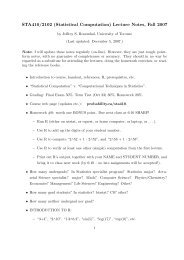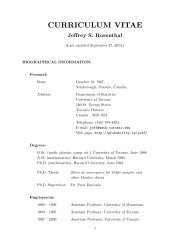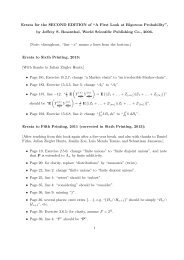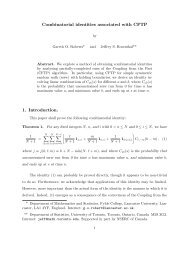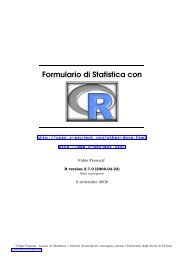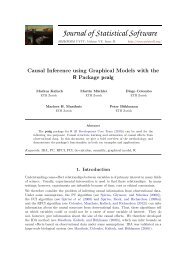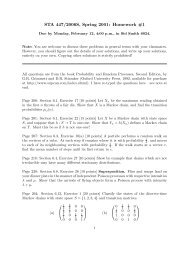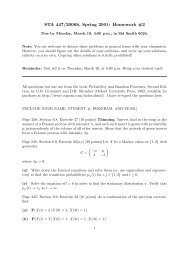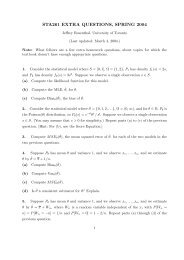final report - probability.ca
final report - probability.ca
final report - probability.ca
You also want an ePaper? Increase the reach of your titles
YUMPU automatically turns print PDFs into web optimized ePapers that Google loves.
expounded here <strong>ca</strong>n be found in Chapter VI of Jean Jacod’s and Albert Shiryaev’s text [JS03], Section III of Cosma<br />
Shalizi’s manuscript entitled Almost None of the Theory Stochastic Processes and Olav Kallenberg’s Probability<br />
textbook (Chapters 7, 14 and 17 in particular), [SK11, Kal97].<br />
It is worth mentioning that the theory expounded here is not the unique theory for which convergence of Markov<br />
processes has developed. In fact, there are three different strands of development that have been used to deal with the<br />
convergence of Markov processes. The method used used, using operator semigroups convergence theorems, is only<br />
one method of proving Markov process convergence. This method was originally spearheaded by H.F. Trotter using<br />
diffusion approximations. A second approach was developed by Daniel Stroock and S.R.S. Varadhan also using<br />
convergence of generators, but instead of using operator semigroups, they authors developed weak compactness<br />
arguments and the martingale characterization of the limit. The last method used requires representing the process<br />
as a solution to a stochastic equation, and then by use of classi<strong>ca</strong>l analysis, one tries to show that convergence of<br />
the equations implies convergence of their solutions.<br />
B.1 Introduction to the Problem<br />
When proofs of weak convergence were given for the Metropolis algorithm (properly res<strong>ca</strong>led) to the Langevin SDE<br />
in this paper, it was supposed that this convergence was under the Skorokhod topology, and this convergence relied<br />
on some general conditions that needs to be elucidated. The main result that provides the necessary characterization<br />
of convergence is the fact that Markov processes <strong>ca</strong>n be expressed according to a corresponding operator<br />
semigroup, which then allows one to characterize the process by the generator of this semigroup. This is the result<br />
of Theorem 8.2 of Chapter 4 in [EK86]. It is through convergence of generators (in the appropriate sense) that<br />
implies convergence of semigroups, which in turn provides convergence of Markov processes. Furthermore, weak<br />
convergence is characterized by convergence in the Skorokhod topology, which is the topology that equips the space<br />
of right continuous functions with left limits in such a manner that the resulting space is complete and separable<br />
(i.e., the space is Polish).<br />
B.2 The Skorokhod Topology<br />
The space D ( R d) is defined to be the space of cádlág functions on [0, ∞), i.e., those functions which are right<br />
continuous and possess left limits. Such functions are also said to possess discontinuities of the first kind, i.e., for<br />
each t ≥ 0 and each function x ∈ D ( R d) , the limits lim x→t + x (s) = x (t) and lim x→t − x (s) = x (t) exist. It would<br />
be a great advantage if for a complete and separable metric space E, there is a metric ρ that makes D ( R d) complete<br />
and separable as well. This metric induces the aforementioned Skorokhod topology. The main usefulness of this<br />
topology for the purposes used in the topic of optimal s<strong>ca</strong>ling is that it allows for a small deformation of the time<br />
s<strong>ca</strong>le. Indeed, for a <strong>probability</strong> space µ, the Skorokhod topology is the coarsest topology for which the mappings:<br />
µ µ (f) are continuous for all bounded continuous functions f on D ( R d) .<br />
B.3 Operator Semigroups<br />
As mentioned in the introduction to this section, operator semigroups are a useful tool for developing the characterization<br />
and convergence of Markov processes. Consider a real Banach space (complete normed vector space) L<br />
with norm ‖·‖.<br />
Definition B.1. (Page 6, [EK86]) A one-parameter family {T (t)} t≥0<br />
of bounded linear operators on L is <strong>ca</strong>lled<br />
a semigroups if<br />
1. T (0) = I, where I denotes the identity matrix.<br />
2. T (s + t) = T (t) T (s) for all s, t ≥ 0.<br />
A semigroup is thus an operator varying with t.<br />
Definition B.2. (Page 6, [EK86]) A semigroup {T (t)} on L is said to be strongly continuous if for all h ∈ L<br />
lim T (t) h = h.<br />
t→0<br />
Definition B.3. (Page 6, [EK86]) A contraction semigroup is such that ‖T (t)‖ ≤ 1 for all t ≥ 0, where<br />
‖T (t) h‖<br />
‖T (t)‖ = sup<br />
h∈L ‖h‖<br />
h≠0<br />
44



